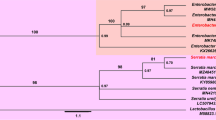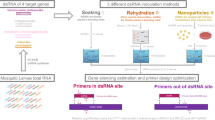Abstract
Neonicotinoids are highly consumed systemic insecticides that mimic acetylcholine (ACh) with a specific mode of action at the nicotinic acetylcholine receptors (nAChRs). The insecticide Actara® (active ingredient thiamethoxam- TMX) is a commercial formulation widely used for the control of various agricultural pest species. However, negative effects of TMX have been observed in non-target organisms. This work aimed to evaluate the biological effects of the commercial formulation Actara® on the aquatic non-target and non-biting larvae of Chironomus xanthus (Diptera). The lethal (LC50) and sublethal (body length, head capsule width, cumulative emergence, and mean time to emergence—EmT50) effects were determined in two subsequent generations (P and F1). The estimated 48 h LC50 for C. xanthus larvae exposed to Actara® was 73.02 µg TMX/L. By looking at the sublethal effects of Actara on the life cycle parameters of C. xanthus, we determined that none of the concentrations used induced a significantly different response in the organisms, compared to the control treatment (NOEC > 2 µg TMX/L). However, the head capsule width in the parental (P) generation exposed to Actara (≥ 0.9 µg TMX/L) was significantly bigger than the head capsule width of control animals. Overall, our results highlight that, at environmentally relevant concentrations, the commercial formulation Actara® is non-toxic to C. xanthus.



Similar content being viewed by others
Data availability
All data generated or analyzed during this study are included in this published article.
References
Anadón A, Ares I, Martínez M et al (2020) Neurotoxicity of Neonicotinoids. In: Advances in Neurotoxicology. Elsevier Inc., pp 167–207. https://doi.org/10.1016/bs.ant.2019.11.005
Anderson TA, Salice CJ, Erickson RA et al (2013) Effects of landuse and precipitation on pesticides and water quality in playa lakes of the southern high plains. Chemosphere 92:84–90. https://doi.org/10.1016/j.chemosphere.2013.02.054
ASTM (1980) Standard practice for conducting acute toxicity tests with fishes, macroinvertebrates and amphibians. Report E-729-80, American Standards for Testing and Materials: Philadelphia, PA, USA
Azevedo-Pereira HMVS, Lemos MFL, Soares AMVM (2011) Behaviour and growth of Chironomus riparius Meigen (Diptera: Chironomidae) under imidacloprid pulse and constant exposure scenarios. Water Air Soil Pollut 219:215–224. https://doi.org/10.1007/s11270-010-0700-x
Barbosa RS, Rotili EA, Santos AMA et al (2022) Eco(toxicological) Assessment of the Neonicotinoid Formulation Actara® Using Planarian Girardia tigrina as Model Organism. Pollutants 2:546–555. https://doi.org/10.3390/pollutants2040035
Barbosa RS, Ribeiro F, Dornelas ASP et al (2023) What does not kill it makes it stronger! The tolerance of the F1 larvae of Chironomus xanthus to a neonicotinoid insecticide formulation. Ecotoxicol Environ Saf 250:114513. https://doi.org/10.1016/j.ecoenv.2023.114513
Borsuah JF, Messer TL, Snow DD et al (2020) Literature review: Global neonicotinoid insecticide occurrence in aquatic environments. Water (Switzerland) 12. https://doi.org/10.3390/w12123388
Brown LA, Ihara M, Buckingham SD et al (2006) Neonicotinoid insecticides display partial and super agonist actions on native insect nicotinic acetylcholine receptors. J Neurochem 99:608–615. https://doi.org/10.1111/j.1471-4159.2006.04084.x
Christen V, Bachofer S, Fent K (2017) Binary mixtures of neonicotinoids show different transcriptional changes than single neonicotinoids in honeybees (Apis mellifera). Environ Pollut 220:1264–1270. https://doi.org/10.1016/j.envpol.2016.10.105
Dornelas ASP, Sarmento RA, Cavallini GS et al (2020) Lethal and sublethal effects of the saline stressor sodium chloride on Chironomus xanthus and Girardia tigrina. Environ Sci Pollut Res 27:34223–34233. https://doi.org/10.1007/s11356-020-09556-9
FAO (2013) Policy support guidelines for the promotion of sustainable production intensification and ecosystem services. Plant Production and Protection Division, Food and Agriculture Organization of the United Nations, Rome
Ferreira-Junior DF, Sarmento RA, Saraiva AS et al (2018) Effects of a Thiamethoxam-Based Insecticide on the Life History of Chironomus xanthus. Water Air Soil Pollut 229. https://doi.org/10.1007/s11270-018-3994-8
Fine JD, Mullin CA, Frazier MT, Reynolds RD (2017) Field Residues and Effects of the Insect Growth Regulator Novaluron and Its Major Co-Formulant N -Methyl-2-Pyrrolidone on Honey Bee Reproduction and Development. J Econ Entomol 110:1993–2001. https://doi.org/10.1093/jee/tox220
Fonseca AL, Rocha O (2004) Laboratory cultures of the native species Chironomus xanthus Rempel, 1939 (Diptera-Chironomidae). Acta Limnol Bras 16:153–161
Gomez-Herrero E, Lebik-ElHadi H, Ait-Amar H et al (2020) Thiamethoxam removal by Fenton and biological oxidation. J Chem Technol Biotechnol 95:913–921. https://doi.org/10.1002/jctb.5953
Ihara M, Matsuda K (2018) Neonicotinoids: molecular mechanisms of action, insights into resistance and impact on pollinators. Curr Opin Insect Sci 30:86–92. https://doi.org/10.1016/j.cois.2018.09.009
Karunker I, Morou E, Nikou D et al (2009) Structural model and functional characterization of the Bemisia tabaci CYP6CM1vQ, a cytochrome P450 associated with high levels of imidacloprid resistance. Insect Biochem Mol Biol 39:697–706. https://doi.org/10.1016/j.ibmb.2009.08.006
Kazuhiko M, Steven DB, Daniel K et al (2001) Neonicotinoids: insecticides actingon insect nicotinic acetylcholinereceptors. Trends Pharmacol Sci 22. https://doi.org/10.1016/S0165-6147(00)01820-4
Main AR, Headley JV, Peru KM et al (2014) Widespread use and frequent detection of neonicotinoid insecticides in wetlands of Canada’s prairie pothole region. PLoS One 9. https://doi.org/10.1371/journal.pone.0092821
Maloney EM, Morrissey CA, Headley JV et al (2017) Cumulative toxicity of neonicotinoid insecticide mixtures to Chironomus dilutus under acute exposure scenarios. Environ Toxicol Chem 36:3091–3101. https://doi.org/10.1002/etc.3878
Melo BS, Ribeiro F, de Saraiva AS et al (2022a) Is there a common mechanism of neonicotinoid resistance among insects? Preliminary results show that F1 larvae of pre-exposed Chironomus xanthus are more tolerant to imidacloprid. J Hazard Mater Adv 6:100073. https://doi.org/10.1016/j.hazadv.2022.100073
Melo BS, Ribeiro F, Saraiva AS et al (2022) The multigenerational effects of clothianidin on Chironomus xanthus: Larvae exposed to this acetylcholine super agonist show no clear resistance. Ecotoxicol Environ Saf 245:114092-b. https://doi.org/10.1016/j.ecoenv.2022.114092
Mesnage R, Antoniou MN (2018) Ignoring Adjuvant Toxicity Falsifies the Safety Profile of Commercial Pesticides. Front Public Health 5. https://doi.org/10.3389/fpubh.2017.00361
Mörtl M, Kereki O, Darvas B, et al (2016) Study on Soil Mobility of Two Neonicotinoid Insecticides. J Chem 2016. https://doi.org/10.1155/2016/4546584
Mullin CA, Frazier M, Frazier JL et al (2010) High Levels of Miticides and Agrochemicals in North American Apiaries: Implications for Honey Bee Health. PLoS One 5. https://doi.org/10.1371/journal.pone.0009754
Naveen NC, Fojtova D, Blahova L et al (2018) Acute and (sub)chronic toxicity of the neonicotinoid imidacloprid on Chironomus riparius. Chemosphere 209:568–577. https://doi.org/10.1016/j.chemosphere.2018.06.102
OECD (2010) OECD/OCDE Guidelines for testing of chemicals. Test Guideline No. 233: sediment-water chironomid life-cycle toxicity test using spiked water or spiked sediment
OECD (2011) OECD/OCDE Guidelines for testing of chemicals. Test guideline No. 235: Chironomus sp., Acute Immobilization Test
Pestana JLT, Loureiro S, Baird DJ, Soares AMVM (2009) Fear and loathing in the benthos: Responses of aquatic insect larvae to the pesticide imidacloprid in the presence of chemical signals of predation risk. Aquat Toxicol 93:138–149. https://doi.org/10.1016/j.aquatox.2009.04.008
Phillips BM, Voorhees JP, Siegler K et al (2021) Acute and Chronic Effects of Clothianidin, Thiamethoxam and Methomyl on Chironomus dilutus. Bull Environ Contam Toxicol 108:884–889. https://doi.org/10.1007/s00128-021-03416-z
Raby M, Zhao X, Hao C et al (2018) Chronic toxicity of 6 neonicotinoid insecticides to Chironomus dilutus and Neocloeon triangulifer. Environ Toxicol Chem 37:2727–2739. https://doi.org/10.1002/etc.4234
Robinson SA, Richardson SD, Dalton RL et al (2017) Sublethal effects on wood frogs chronically exposed to environmentally relevant concentrations of two neonicotinoid insecticides. Environ Toxicol Chem 36:1101–1109. https://doi.org/10.1002/etc.3739
Saraiva AS, Sarmento RA, Rodrigues ACM et al (2017) Assessment of thiamethoxam toxicity to Chironomus riparius. Ecotoxicol Environ Saf 137:240–246. https://doi.org/10.1016/j.ecoenv.2016.12.009
Sprague JB, Fogels A (1977) Watch the Y in bioassay, Halifax. Nova Scotia. Environ Prot Serv Tech Rep 107–118
Stoughton SJ, Liber K, Culp J, Cessna A (2008) Acute and chronic toxicity of imidacloprid to the aquatic invertebrates Chironomus tentans and Hyalella azteca under constant- and pulse-exposure conditions. Arch Environ Contam Toxicol 54:662–673. https://doi.org/10.1007/s00244-007-9073-6
Thany SH (2011) Thiamethoxam, a poor agonist of nicotinic acetylcholine receptors expressed on isolated cell bodies, acts as a full agonist at cockroach cercal afferent/giant interneuron synapses. Neuropharmacology 60:587–592. https://doi.org/10.1016/j.neuropharm.2010.12.008
Van der Sluijs JP, Simon-Delso N, Goulson D et al (2013) Neonicotinoids, bee disorders and the sustainability of pollinator services. Curr Opin Environ Sustain 5:293–305. https://doi.org/10.1016/j.cosust.2013.05.007
Watts MM, Pascoe D (2000) Comparison of Chironomus riparius meigen and Chironomus tentans Fabricius (Diptera: Chironomidae) for assessing the toxicity of sediments. Environ Toxicol Chem 19:1885–1892. https://doi.org/10.1897/1551-5028(2000)019%3c1885:COCRMA%3e2.3.CO;2
Yamamuro M, Komuro T, Kamiya H et al (2019) Neonicotinoids disrupt aquatic food webs and decrease fishery yields. Science (1979) 333:620–623. https://doi.org/10.1126/science.aax3442
Acknowledgements
The authors would like to thank Coordenação de Aperfeiçoamento de Pessoal de Ensino Superior (CAPES-Brazil; Doctoral Program process DS-PPG-PV 88887.653785/2021-00) and PROCAD-AMAZONIA-DRI (PROGRAMA NACIONAL DE COOPERAÇÃO ACADÊMICA NA AMAZÔNIA-DRI) (Doctoral Exchange Program, Edital nº 21/2018 processes 88881.666078/2022-01 and 88881.642710/2021-01), Financing Code 001 CAPES. Renato A. Sarmento thanks the Conselho Nacional de Desenvolvimento Científico Tecnológico (CNPq-Brazil), through the Research Productivity programme (Project 306011/2022-0) and Universal Project 405875/2021-5. Fabianne Ribeiro thanks the Brazilian National Council for Scientific and Technological Development (CNPq) for the visiting researcher grant (PV 350118/2022-1). We also acknowledge the financial support to CESAM by Fundação para a Ciência e a Tecnologia (FCT/MCTES) through national funds (UIDP/50017/2020+UIDB/50017/2020+ LA/P/0094/2020).
Funding
Coordenação de Aperfeiçoamento de Pessoal de Ensino Superior (CAPES-Brazil and PROCAD-AMAZONIA—Doctoral Exchange Program); Conselho Nacional de Desenvolvimento Científico Tecnológico (CNPq-Brazil); Fundação para a Ciência e a Tecnologia (FCT/MCTES—UIDP/50017/2020 + UIDB/50017/2020 + LA/P/0094/2020).
Author information
Authors and Affiliations
Contributions
Rone S. Barbosa: Investigation, Data Curation,Writing—Original draft, Writing—Review & Editing, Formal analysis; Fabianne Ribeiro: Writing—Original draft, Writing—Review & Editing, Formal analysis; Eliane Aparecida Rotili: Data Curation, Supervision, Formal analysis; Rosaina Sousa Venega: Data Curation, Formal analysis; Aline Silvestre Pereira Dornelas: Writing—Review & Editing, Formal analysis; Amadeu M.V.M. Soares: Conceptualization, Resources, Writing—Review & Editing, Project administration, Funding acquisition; Carlos Gravato: Conceptualization – Supervision – Resources—Writing—Original draft, Writing—Review & Editing, Formal analysis; Renato Almeida Sarmento: Resources, Conceptualization, Supervision, Writing—Review & Editing, Project administration, Funding acquisition.
Corresponding author
Ethics declarations
Ethical approval
Not applicable.
Consent to participate and publish
Not applicable.
Competing interests
The authors declare that they have no known competing financial interests or personal relationships that could have appeared to influence the work reported in this paper.
Additional information
Responsible Editor: Giovanni Benelli
Publisher's note
Springer Nature remains neutral with regard to jurisdictional claims in published maps and institutional affiliations.
Rights and permissions
Springer Nature or its licensor (e.g. a society or other partner) holds exclusive rights to this article under a publishing agreement with the author(s) or other rightsholder(s); author self-archiving of the accepted manuscript version of this article is solely governed by the terms of such publishing agreement and applicable law.
About this article
Cite this article
Barbosa, R.S., Ribeiro, F., Rotili, E.A. et al. Is Actara® a less toxic neonicotinoid formulation? A multigenerational study using the non-target organism Chironomus xanthus. Environ Sci Pollut Res 30, 93779–93785 (2023). https://doi.org/10.1007/s11356-023-28956-1
Received:
Accepted:
Published:
Issue Date:
DOI: https://doi.org/10.1007/s11356-023-28956-1




